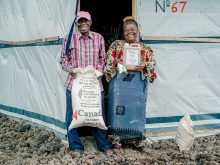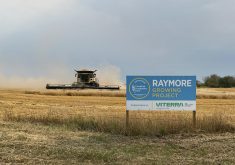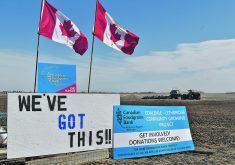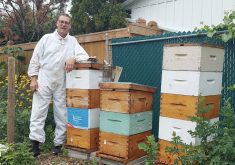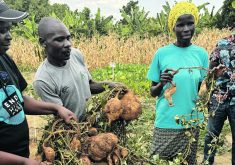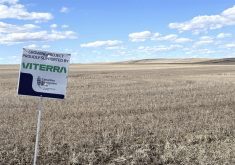Canadian Foodgrains Bank project grows barley so it can cater to the region’s feedlots, dairies and poultry producers
COALDALE, Alta. — Barley dust was among the condiments sprinkled on burgers and hotdogs Aug. 29 when the Coaldale Lethbridge Community Growing Project harvested a quarter section of crop.
A lunch sponsored by local businesses is one attraction for the event, but so is the sight of the many combines and trucks involved in threshing and hauling the grain. Proceeds from sale of the crop go to the Canadian Foodgrains Bank for use on projects designed to help feed the hungry in other countries.
“We’ve chosen barley specifically for the purpose of making sure that we can get our neighbours and those in our region involved,” said project organizer Larry Penner.
Read Also

Farming Smarter receives financial boost from Alberta government for potato research
Farming Smarter near Lethbridge got a boost to its research equipment, thanks to the Alberta government’s increase in funding for research associations.
“This is a large dairy, feed yard location and so many of our clients that have bought some of the grain that’s coming off the field today are local ag producers that are feed yards or dairies or poultry producers looking to utilize this grain in their own operations.”
The barley harvested from this field was actually pre-sold in June during the Mennonite Central Committee auction event held in Coaldale.
“With both of these organizations being so involved in world relief, it was an awesome opportunity to partner with them back in early June in order to get this done,” said Penner.
The crop harvested last week yielded 130 bushels per acre and 394 bales of straw, making it above average in yield and quality. Penner said pre-sale of the crop raised $177,000. All seed, fertilizer and herbicides were donated by local businesses.
Andre Visscher, regional co-ordinator in Alberta for the foodgrains bank, said the federal government matches donations with $4 for every $1 raised in projects like this. However, that matching is to a maximum of $25 million per year. Foodgrains bank projects usually exceed that, averaging about $40 million annually, he said.
“We always go further, so not every dollar is actually matched.”
Visscher said there are about 40 growing projects in Alberta this year and most of them look promising in terms of potential return.
“They’re all doing pretty good. Northern Alberta, the start was a little difficult but they’re harvesting next week. In southern Alberta, under irrigation, crops are looking very well. Picture Butte got hailed out and they went for silage. Dryland is a little tough but overall we’re pretty satisfied.”
The foodgrains bank has also started Grow Hope projects, a way to include city dwellers in growing projects. One is near Calgary and the other near Edmonton.
“City people, they can sponsor an acre and then they can come out to the field. We give them regular updates by email how the crop is doing. So we’re trying to help people in cities really understand how a crop is grown,” said Visscher.
About 400 acres are involved and there is room for more sponsors.
Some of the funds from this year’s growing projects are earmarked to help those in Africa affected by Cyclone Idai, which caused flooding and damage in Mozambique, Malawi and Zimbabwe in March.
“We started there with emergency food after the flooding and then (helping recover from) the damage that was done. Now we’re getting into the next stage where we’re helping people to grow crops again, getting seed and tools so they can look after themselves,” said Visscher.
“The need is very great.”
Assistance is also provided to refugees from Syria and Myanmar.
George Lubberts, an agronomist from Nobleford, Alta., has seen a number of foodgrains bank projects in Africa. Most recently he visited Uganda, where the organization helps fund conservation agriculture programs.
“It’s a way of reducing moisture loss, nutrient loss and soil loss through cover crops, through mulching and through reduced tillage,” Lubberts said about the programs.
“The results we’ve been seeing have been amazing. People that could normally barely feed themselves — you’ve got to remember all these people are subsistence farmers so they were just basically producing enough to feed their family. Now they are able to have excess to sell in the market, for school fees or medical care or building houses.”






